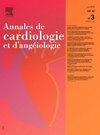Cardiomyopathie dilatée hypocalcémique réversible induite par un hypoparathyroïdisme secondaire décompensé après une infection à la Covid-19 : à propos d’un cas
IF 0.3
Q4 Medicine
引用次数: 0
Abstract
Introduction
Hypocalcemia, though rare, can lead to heart failure with reduced ejection fraction and dilated cardiomyopathy. It may result from various etiologies, and its manifestations range from mild to life-threatening. Cardiovascular complications of hypocalcemia include QT interval prolongation, ventricular arrhythmias, and heart failure.we report a rare case of reversible hypocalcemic dilated cardiomyopathy.
Case Report
We present the case of a 41-year-old woman with secondary hypoparathyroidism following thyroidectomy in 2018. She was treated with levothyroxine, calcitriol, and calcium and vitamin D supplements. Following a Covid-19 infection in May 2021, her hypoparathyroidism decompensated, leading to severe hypocalcemia, which was inadequately managed. Five months later, she presented with worsening dyspnea, orthopnea, and bilateral lower limb edema. Clinical examination revealed positive Chvostek and Trousseau’s signs, indicating severe hypocalcemia. ECG showed sinus tachycardia with QT prolongation, and echocardiography revealed a dilated left ventricle with an ejection fraction (EF) of 29%. Despite normal coronary angiography, a CT scan showed bilateral pleural effusion and superior vena cava thrombosis. Laboratory findings confirmed hypocalcemia with elevated phosphorus and low parathyroid hormone levels. Intravenous calcium correction and heart failure management led to symptomatic improvement and normalization of serum calcium within one week. Echocardiography showed gradual recovery, with EF improving to 38% at 8 weeks and 57% after 6 months.
Discussion
Calcium plays a critical role in cardiac contractility, and its deficiency can severely impact myocardial function. Hypocalcemia following thyroidectomy is a known complication and can worsen during systemic infections like Covid-19. While hypocalcemia-induced cardiomyopathy is reversible with proper treatment, it requires early recognition and aggressive correction. *
Conclusion
This case highlights the importance of monitoring calcium levels in patients with hypoparathyroidism, especially in the context of systemic infections, to prevent potentially life-threatening complications like hypocalcemic cardiomyopathy. Proper diagnosis and treatment of hypocalcemia can lead to full recovery of cardiac function
COVID -19感染后继发性失代偿性甲状腺功能减退引起的可逆低钙扩张性心肌病:关于一个病例
低钙血症虽然罕见,但可导致心力衰竭,伴射血分数降低和扩张性心肌病。它可能由多种病因引起,其表现从轻微到危及生命不等。低钙血症的心血管并发症包括QT间期延长、室性心律失常和心力衰竭。我们报告一例罕见的可逆性低钙扩张型心肌病。病例报告:我们报告了一例41岁的女性,在2018年甲状腺切除术后出现继发性甲状旁腺功能低下。患者接受左旋甲状腺素、骨化三醇、钙和维生素D补充剂治疗。在2021年5月感染Covid-19后,她的甲状旁腺功能减退失代偿,导致严重的低钙血症,但治疗不当。5个月后,患者出现呼吸困难、矫直和双侧下肢水肿。临床检查显示Chvostek和Trousseau征象阳性,提示严重的低钙血症。心电图显示窦性心动过速伴QT延长,超声心动图显示左心室扩张,射血分数(EF)为29%。尽管冠状动脉造影正常,CT扫描显示双侧胸腔积液和上腔静脉血栓形成。实验室结果证实低钙血症伴高磷和低甲状旁腺激素水平。静脉补钙和心力衰竭治疗使症状在一周内得到改善,血清钙恢复正常。超声心动图显示逐渐恢复,8周时EF改善至38%,6个月后改善至57%。钙在心脏收缩中起着至关重要的作用,缺乏钙会严重影响心肌功能。甲状腺切除术后的低钙血症是一种已知的并发症,在Covid-19等全身感染期间可能会恶化。虽然低钙血症引起的心肌病在适当治疗下是可逆的,但它需要早期识别和积极纠正。*结论:本病例强调了监测甲状旁腺功能低下患者钙水平的重要性,特别是在全身性感染的情况下,以预防潜在的危及生命的并发症,如低钙性心肌病。正确诊断和治疗低钙血症可使心功能完全恢复
本文章由计算机程序翻译,如有差异,请以英文原文为准。
求助全文
约1分钟内获得全文
求助全文
来源期刊
CiteScore
0.60
自引率
0.00%
发文量
68
审稿时长
6-12 weeks
期刊介绍:
Organe scientifique de référence fondé en 1951, les Annales de cardiologie et d''angéiologie abordent tous les domaines qui intéressent quotidiennement les cardiologues et les angéiologues praticiens : neurologie et radiologie vasculaires, hémostase, diabétologie, médecine interne, épidémiologie et prévention.
Les Annales de cardiologie et d''angéiologie sont indexées aux grandes bases de données et publient rapidement, et en conformité avec les normes internationales de publication scientifique, des articles en français sur la pathologie cardiaque.

 求助内容:
求助内容: 应助结果提醒方式:
应助结果提醒方式:


